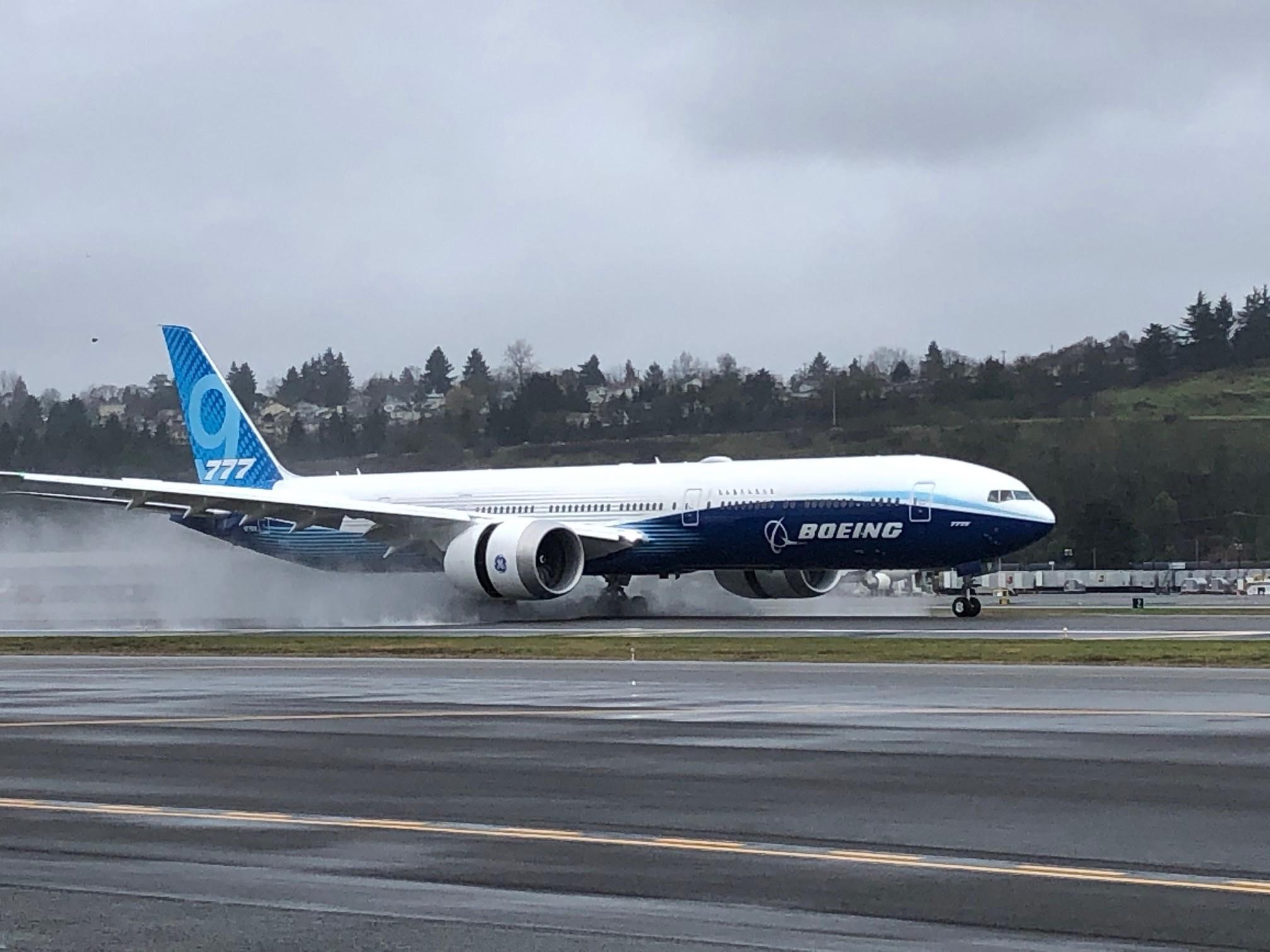
LOS ANGELES AND SEATTLE – After two days of delays caused by bad weather Boeing’s 777-9, the first of the company’s new long range 777X flagship family, successfully completed its initial test flight on Jan. 25 to mark the start of an intense and closely scrutinized certification campaign.
The 777-9 took to the air from the company’s Everett, Wash. facility at Paine Field at 10:09 a.m. and landed back at Boeing Field, Seattle after a 3 hr. 51 min. flight. It was flown by 777X chief test pilot Van Chaney and Craig Bomben, Boeing’s vice president for flight operations and chief test pilot.
Although delayed by over six months while durability issues with the aircraft’s General Electric GE9X engines were corrected, the completion of the first flight marks a significant boost for the embattled company in the wake of the 737 MAX crisis and a recent slump in twin-aisle orders. Coming more than 25 years after the first flight of the original 777 and almost 17 years after the first flight of the GE90-115B-powered 777-300ER, the test debut of the 777-9 also marks the start of a critical new phase of the company’s long-term widebody strategy.
The flight began with a standard first-of-model departure to the north from Paine Field’s runway 34 Left. The 777-9, with the Boeing code WH001, disappeared almost immediately after take-off into the low overcast before heading to eastern Washington where systems checks as well as basic flying qualities and handling assessments were conducted at an altitude of 15,000 ft. and speeds between 270 kt. and 207 kt. A series of low-speed checks were made while the crew flew a racetrack pattern over the northern part of the state. The 777-9 was then flown southwest for a photoshoot session around Mt. Ranier before heading north to return to Seattle for its first landing on Boeing Field’s runway 14R.
Observers noted the relatively shallow pitch attitude used for rotation on take-off as well as for the landing flare, most likely associated with the aircraft’s 252 ft. overall length. The 777-9 is the largest twinjet ever built and is 43 ft. longer than the initial 777-200 variant. The very low noise signature of the GE9X engines was also noted on both departure and arrival. The crew reported the aircraft performed well and flew as expected, despite the increased fuselage length and wingspan. Following a brief post-flight ground test period WH001 will continue to conduct initial airworthiness, basic envelope expansion and flutter clearance testing. The second of four dedicated test aircraft, WH002, is expected to join the program in coming weeks.
Initial tests using WH001 will clear the way for FAA Type Inspection Authority (TIA) which will enable Boeing and the regulatory authority to begin the certification campaign along with ongoing engineering tests. Much of the testing will focus on the performance of the new 235.4-ft. span wing, of which almost 24 ft. is made up of the folding wing tip sections. The wing is Boeing’s fourth generation large composite design and incorporates a modified trailing edge variable camber system derived from the 787 as well as a maneuver load alleviation system to limit stresses on the wing and reduce structural weight.
The folding tip feature, which performed as expected with rapid deployment and retraction before and after take-off, will also require a slightly greater-than-usual emphasis on ground testing. Developed to enable the 777-8/9 to operate at ICAO Code E standard taxiways, gate and ramp areas in common with the current 747-400 and 777-300ER, yet provide better aerodynamic efficiency for cruise, the folding wingtip is extended by a command from the flight crew before take-off. However, on landing the system is designed to automatically fold after touchdown as soon as ground speed slows below 50 kt.
Testing will evaluate standard and non-standard operations of the device, which in normal operational mode will take 20 sec. to fully extend and fold. For non-standard operations, such as in the event of a rejected take-off (RTO), the auto fold feature is enabled along with autobrakes and speed brakes if the take-off is abandoned at a ground speed of 85 kt. or above. However, if the RTO occurs below 85 kt. the auto fold function will not trigger and the crew will need to manually activate the wing tip folding system.
The folding wing tips are the first of their kind to feature on a commercial airliner and will be tested to ensure they meet a set of special certification conditions developed by the FAA. Tests will cover checks of additional safeguards to ensure against accidental retraction in flight or unlocking during take-off, as well as checking robust performance in gusting winds. Test standards for the wing tips are designed to conform with the same certification requirements as other moving surfaces such as ailerons and flaps.
First deliveries of the 777-9 are expected to begin to launch customer Emirates in 2021. After recent adjustments the 777X family orderbook stands at 309, including an unspecified number of the 777-9’s forthcoming shorter 777-8 sibling.


Comments